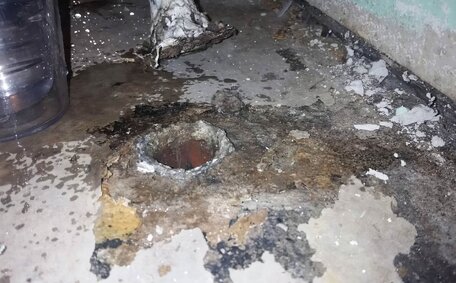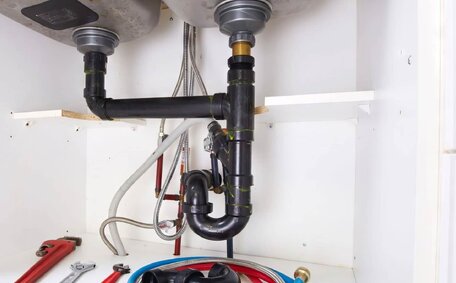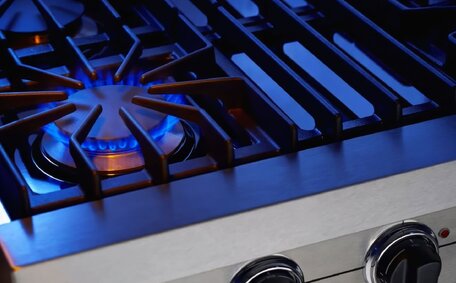Recognizing signs of gas leaks and when to shut off gas
Quick detection of a gas leak is essential for the safety of gas hot water systems and overall household protection. Be alert for the following typical gas leak indicators:
- A strong "rotten egg" odour, which is added to natural gas to help detect leaks
- Hissing, whistling or roaring sounds emerging from your gas line or gas appliance fittings
- Dead or dying vegetation in an otherwise green area might indicate gas leaking away, affecting nearby flora
- Flames coming from the ground or burnt vegetation and dirt around pipelines
If you observe these warning signs, evacuate the area immediately and contact emergency services. It’s crucial to turn off the gas supply promptly to ensure safety. Avoid operating electrical devices or lights to prevent sparks that could ignite the gas.
After evacuating, shut off the gas by locating the main valve near the gas meter and rotating it to halt the gas flow.
If you can smell a very strong gas odour inside your home, you should also open all doors and windows to ventilate while avoiding any open flames or sparks.
Gas leaks, especially around your hot water system in confined places like basements, pose serious risks. The gas can accumulate to explosive concentrations, so extra caution is essential in these areas.
Prompt recognition of gas leaks and safely disconnecting the gas supply are critical to prevent fires, explosions, and carbon monoxide poisoning.
Locating the gas meter and main shutoff valve
The meter box, usually a grey metal case, is located on an outside wall of your home. It may be at the front, side of your home, or back, but you should know where to locate it. Keep the pathway to your gas meter clear to ensure quick access for turning off the gas.
Within the meter box, you’ll see pipelines for your natural gas, along with a shut-off valve. The safety valve, attached to the outlet pipe, features a handle that you can turn to interrupt the gas supply.
To manage your hot water supply, manipulate valves as needed to stop flow and sustain system integrity. This valve is sometimes labelled as "Emergency Shut-Off".
If you utilise LP gas with an LPG cylinder, consider the process of turning gas using the cylinder’s shutoff valve. For mains gas, there may also be an emergency shutoff valve near the point where the gas pipe enters your property off main, though the main valve at the metre is the most common.
Familiarity with the location of your meter and valve ensures swift action in an emergency. Make sure each household member knows how to safely turn off your gas in case of emergencies. Ensure easy access to the gas valve to save critical time during emergencies.
Steps to shut off gas at the meter
For an emergency gas shut-off at the meter, follow these steps:
- Find the gas meter enclosure, often a grey metal box fitted to an external wall of your house.
- Identify the gas shutoff valve connected to the outlet pipe to manage your home’s gas supply. It will have a handle that can turn 90 degrees. You may need an adjustable wrench to loosen and turn the valve if it is stiff.
- Ventilate the area thoroughly to prevent gas accumulation, including opening all doors and windows. Extinguish all naked flame sources and do not operate electrical switches that could start or stop flow gas.
- Wear gloves for grip and protection. Grasp the valve handle firmly with the wrench and turn gas clockwise 90 degrees until the handle is crosswise to the pipe, indicating that the gas supply is off.
- Contact your gas company to report the leak immediately on the gas leak 1800 427 emergency number. Do not attempt to turn the gas back on yourself.
Following these measures to interrupt the water gas supply at the appropriate valve can help mitigate risks of fires, explosions, and poisoning. Ensure all residents know the shutdown procedure or have a licensed plumber provide instructions for emergencies.
When gas can be turned back on safely
Only when a licensed gasfitter has approved and resolved the issues leading to the interruption is it safe to turn your gas back on. This often requires having a licenced professional inspect the gas system first.
Prior to reactivating your gas supply, ensure to:
- Confirm a licenced gas fitter has repaired any defects impacting your gas stove and hot water system
- Verify that all your gas appliances pilot mechanisms have been scrutinised and deemed safe to operate after the shut-off
- Make sure any faulty parts have been replaced
- Confirm appliances are properly reconnected and sealed if they were disconnected
- Improve air circulation by opening windows and doors and turn off any related water valves
When the licensed gas technician turns the supply back on, a key safety measure is to inspect gas appliances pilot integrity by checking for leaks again with soapy water. It is also crucial to relight pilot lights correctly by following the appliance manuals.
If pilot lights fail to reignite after multiple tries, or you detect gas odours, you can also turn off all gas sources again and urgently engage a professional. Do not attempt to DIY further repairs.
Licensed gas fitters possess the specialised training, equipment, and detectors to safely manage gas systems post-shut-off. Ensuring certified gas fitters handle the entire process reduces fire, explosion and poisoning risks.
Getting professional help for gas leaks and appliance issues
Unaddressed gas leaks and faulty appliances can rapidly become hazardous without the intervention of qualified professionals. Attempting DIY repairs on gas systems risks leaks, explosions, poisoning, electrocution and fire.
If you encounter a strong gas smell or suspect an appliance issue like an intermittent pilot light, lack of ignition or abnormal sounds/smells, immediately turn off main valve and call a licenced gas fitter for inspection. Using your contact details such as phone, email or an online request form are good initial methods to explain the issues.
Qualified technicians will conduct gas leak detection, pressure tests, and diagnostic evaluations at your home. With comprehensive training and methane detection tools, they can pinpoint and resolve problems that comply with all gas safety regulations. A system is deemed safe for reactivation only after a qualified gas fitter certifies it.
Ignoring small gas leaks or appliance malfunctions may result in serious accidents. Our team boasts over 40 years of experience in managing all gas-related repairs and gas installation projects to the highest safety standards. Call your local Bankstown Plumbing on 1300 349 338 or reach out at jobs@bankstownplumbingservices.com.au to arrange service from our technicians.
Preventive measures for gas safety
There are several key steps households should take to promote gas safety:
- Maintain a clear area around your gas appliances and meter, crucial for household safety, especially in bushfire-prone zones. In emergency situations, authorities might mandate the shut-off of gas.
- Teach your family to recognise the unique smell of gas and the correct response upon detection.
- Regular rehearsing of how to locate and operate your gas shutoff valve ensures swift action in emergencies.
- Consider installing carbon monoxide detectors for early warning of potential exposure.
- Smelling gas or suspecting an appliance fault requires immediate evacuation and professional assistance.
Taking preventive measures guarantees gas safety and reduces household risk in accord with Australian standards.






